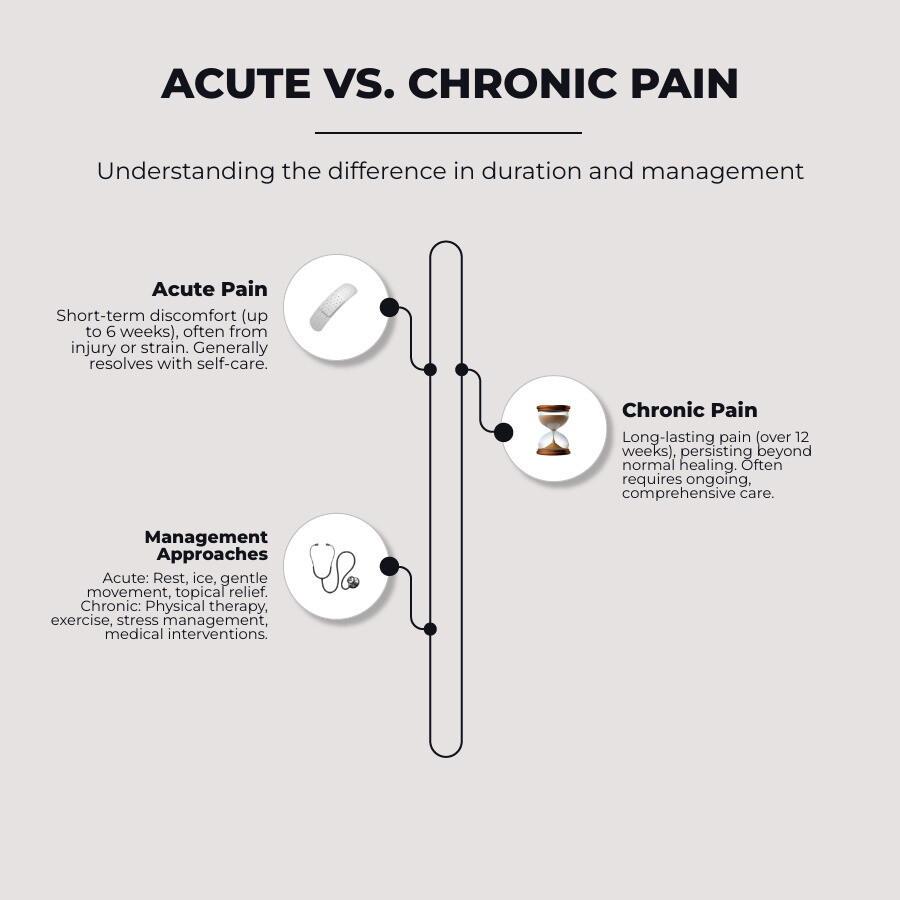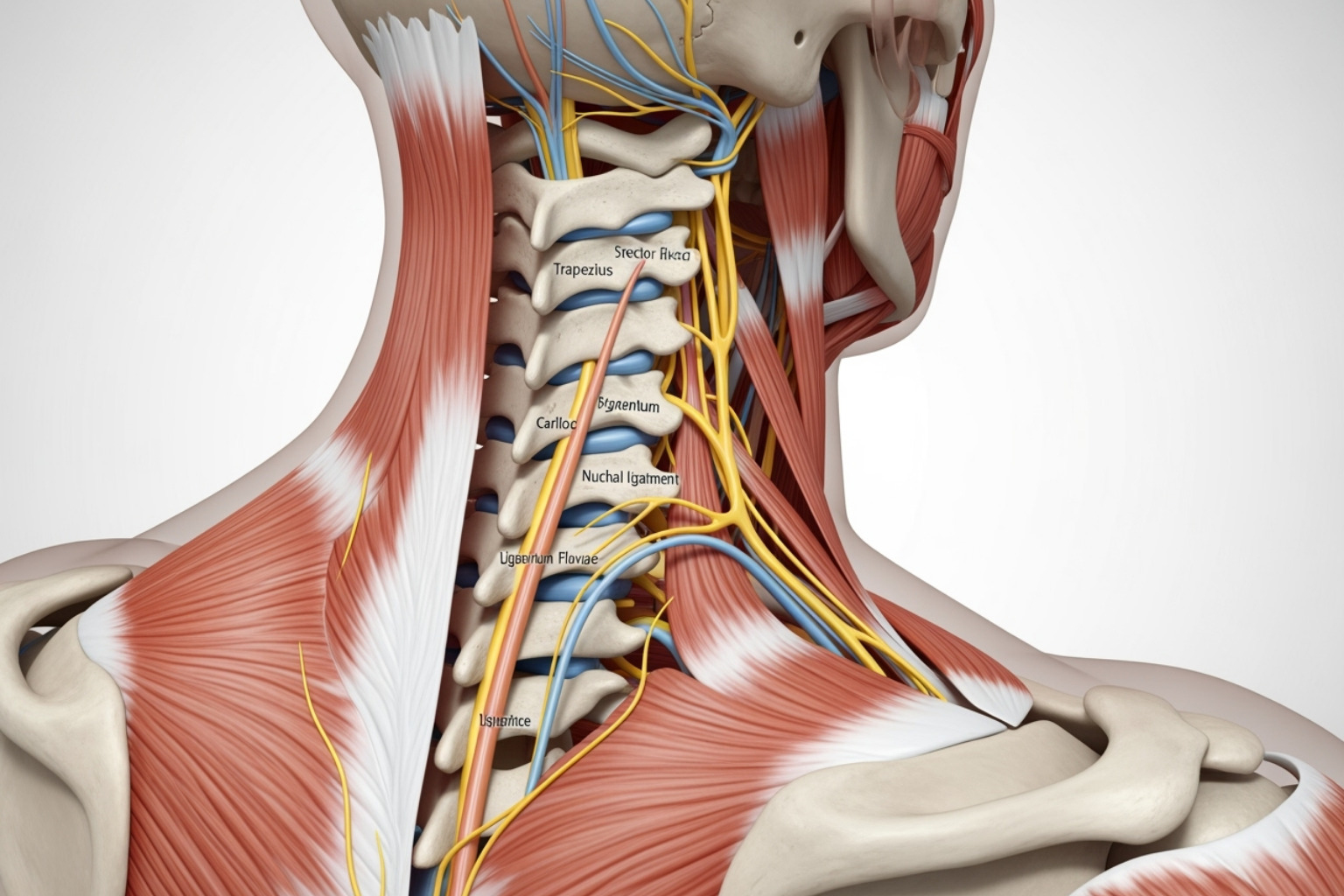Why Your Back and Neck Pain Matters (And What It's Telling You)
Back and neck pain is a near-universal experience. In fact, eight out of 10 people will experience it in their lifetime, making it one of the most common health complaints worldwide. With around 20% of people experiencing neck discomfort daily, and back pain being the leading cause of disability in working adults, understanding this pain is crucial.
Quick Answer: Common Causes of Back and Neck Pain
- Muscle strain from overuse, poor posture, or improper lifting
- Injury from falls, accidents, or sports
- Aging including degenerative disc disease, arthritis, and spinal stenosis
- Lifestyle factors like prolonged sitting, "tech neck," obesity, and smoking
- Nerve-related issues such as herniated discs or pinched nerves
- Stress and tension causing chronic muscle tightness
Your spine is a complex structure supporting your head, enabling movement, and protecting vital nerve pathways. When something goes wrong--be it a strained muscle, an inflamed joint, or a compressed nerve--your body sends pain signals as a warning.
Understanding these signals is the first step toward relief. Most issues resolve with self-care, but some symptoms require medical attention. Knowing the difference can prevent minor discomfort from becoming a chronic condition. This guide will help you decode what your body is telling you, recognize warning signs, and find practical strategies for relief.

Decoding the Discomfort: Common Causes and Types of Pain
Your back and neck are complex, with 33 vertebrae, cushioning discs, ligaments, muscles, and nerves. This intricacy allows for incredible movement but also makes the spine vulnerable. Understanding the cause of your pain is the first step toward relief.
The Root Causes of Back and Neck Pain
Muscle strain and overuse are the most common triggers. Activities like moving furniture, intense workouts, or even prolonged gardening can strain the muscles and ligaments supporting your spine. According to the NIH, this is a primary reason for back pain.
Other common causes include:
- Trauma and Injury: A fall, car accident (whiplash), or sports impact can damage spinal structures.
- Aging: Over time, discs lose flexibility (degenerative disc disease), joints can develop arthritis, and the spinal canal may narrow (spinal stenosis).
- Poor Posture & "Tech Neck": Hunching over screens puts immense strain on your neck and upper back. For every inch your head tilts forward, its effective weight on your neck doubles.
- Improper Lifting: Bending at the waist instead of using your legs puts excessive stress on your lower back, leading to muscle strains and disc issues.
- Obesity and Smoking: Extra weight stresses the spine, while smoking accelerates disc degeneration and slows healing.
- Stress and Tension: Emotional stress causes muscles to tighten, leading to tension headaches and spasms. Your mental state directly impacts your physical comfort.
For more on specific lower back issues, see our guide on Lower Back Pain Causes.

Understanding Your Pain: From Dull Aches to Sharp Shocks
The type of pain you feel offers important clues:
- Mechanical Pain: A dull, localized ache in your back and neck that worsens with movement and improves with rest. It often stems from strained muscles or joint issues.
- Aching and Stiffness: Morning stiffness that eases with movement often signals inflammation, arthritis, or degenerative disc changes.
-
Nerve-Related Pain: This is a sharp, shooting, or burning pain that travels down an arm or leg. It may be accompanied by numbness, tingling, or weakness, indicating a nerve is compressed or irritated.
- Sciatica: A classic example, where pain shoots from the lower back down the leg. This happens when the sciatic nerve is compressed, often by a herniated disc. Learn more from our guide on Sciatica Pain Symptoms.
- Cervical Radiculopathy: Similar to sciatica but in the neck, causing pain, numbness, or weakness to radiate down the arm.
Acute vs. Chronic Pain: How Management Differs
The timeline of your pain is critical for treatment.
- Acute pain starts suddenly, often tied to a specific event, and typically lasts from a few days to six weeks. Most acute back and neck pain resolves with self-care.
- Chronic pain persists for three months or longer. It can be constant or intermittent and often continues after the initial injury has healed, impacting work, sleep, and mood.
Management strategies differ significantly. Acute pain responds well to rest, ice, heat, over-the-counter pain relievers, and topical solutions like Neuropasil Nerve Pain Relief Cream for targeted relief. The goal is to reduce pain and support healing.
Chronic pain requires a more comprehensive approach, often involving physical therapy, exercise, stress management, and sometimes medical interventions. The focus is on improving overall quality of life. For more strategies, read our article on Living Well with Chronic Pain.
Red Flags and Risks: When to See a Doctor for Back and Neck Pain
Most back and neck pain improves with self-care, but some symptoms are urgent warnings. Knowing when to call a doctor or go to the emergency room can prevent lasting complications.
Warning Signs You Shouldn't Ignore
Seek immediate medical attention for back and neck pain accompanied by any of these red flags:
- Loss of bladder or bowel control: This is a medical emergency, potentially signaling severe nerve compression (cauda equina syndrome).
- Numbness in the groin or inner thighs ("saddle anesthesia"): Also a sign of cauda equina syndrome that requires immediate care.
- New or worsening weakness in arms or legs: Difficulty lifting a foot (foot drop) or gripping objects suggests significant nerve compression.
- Fever: Pain accompanied by a temperature of 100.4 degrees F (38 degrees C) or higher could indicate a spinal infection [4].
- Unexplained weight loss: When paired with persistent pain, this can be a sign of a more serious underlying condition.
- Pain after significant trauma: Any pain following a fall, car accident, or major injury needs professional evaluation for potential fractures.
- Severe, unrelenting pain: Pain that worsens despite rest, disrupts sleep, or doesn't improve with over-the-counter medication warrants a doctor's visit.
- Persistent pain beyond 12 weeks: If pain lasts three months, it's time to see a spine specialist.
If you experience any of these red flags, do not wait. Prompt medical care is essential.
Potential Long-Term Complications of Untreated Pain
Ignoring persistent back and neck pain can lead to a cascade of problems that affect your entire life.
- Permanent nerve damage: Prolonged nerve compression can result in lasting numbness, weakness, or loss of function. Our guide on Nerve Pain explains this in more detail.
- Reduced mobility and disability: A vicious cycle where pain leads to inactivity, causing muscle weakness and joint stiffness, which makes movement even more painful.
- Mental health issues: Chronic pain is exhausting and is strongly linked to depression and anxiety, leading to social withdrawal and isolation.
- Weight gain: Limited activity due to pain often leads to weight gain, which in turn puts more stress on the spine, worsening the pain.
These factors combine to dramatically decrease your overall quality of life. Early intervention is key to preventing these complications and reclaiming your life from pain.
Your First Line of Defense: At-Home Relief and Prevention
Most acute back and neck pain responds well to simple, at-home strategies. This is your toolkit for managing discomfort and preventing it from returning.

Immediate Self-Care for Acute Aches
When pain strikes unexpectedly, here's what to do:
- Rest, but keep moving: Avoid strenuous activity for a day or two, but don't stay in bed. Gentle movement is crucial for healing [4].
- Ice first, then heat: For the first 48 hours, apply an ice pack for 15-20 minutes at a time to reduce inflammation. After that, switch to heat (heating pad, warm bath) to relax tight muscles [4].
- Over-the-counter medications: Ibuprofen or naproxen can help with pain and inflammation. Follow package directions [4].
- Topical relief creams: For targeted relief, products like Neuropasil Nerve Pain Relief Cream can be very effective. Its natural ingredients--Aloe, Urea, and Menthol--deliver soothing relief directly to the source of discomfort. It's a great tool for muscle strains, general achiness, and nerve-related pain.
For more on recovery, see our Muscle Strain Treatment guide and learn how topicals work in The Ultimate Guide to Muscle Relief Cream.
The Power of Posture and Sleep
Your daily habits significantly impact your spinal health. Small changes can prevent future back and neck pain.
- Ergonomics: Set up your workspace to support your body. Position your monitor at eye level, keep feet flat on the floor, and use a lumbar cushion. Take frequent breaks to stand and stretch.
- Lifting: Always bend at your knees and hips, not your waist. Keep the object close to your body and use your leg muscles to lift. Avoid twisting while lifting.
- Sleep Position: The best positions are on your back (with a pillow under your knees) or on your side (with a pillow between your knees) to maintain spinal alignment. Avoid sleeping on your stomach, as it strains both the neck and back.
- Mattress and Pillow: A supportive, non-sagging mattress and a pillow that keeps your head in a neutral position are essential investments in your health.
These tips can also help with related issues like Shoulder Muscle Pain.
Simple Stretches and Exercises for a Healthier Back and Neck
Movement is medicine for your spine. Regular, gentle exercise can prevent and relieve pain.
- Cat-Cow Stretch: On all fours, alternate between arching your back (Cow) on an inhale and rounding your spine (Cat) on an exhale to mobilize the spine.
- Chin Tucks: Sit or stand tall and gently pull your chin straight back to create a double chin. This combats forward head posture and relieves neck tension.
- Knee-to-Chest Stretch: Lie on your back and gently pull one knee, then the other, then both, toward your chest to release lower back tension.
- Shoulder Blade Squeezes: Sit or stand tall and squeeze your shoulder blades together to strengthen upper back muscles.
Core strength and flexibility are your spine's best friends. A strong core acts as a natural brace. For a detailed program, Dr. McLain's Recommended Cervical Spine Exercise Program is an excellent resource. Be patient; consistency is key, and you should feel a stretch, not sharp pain.
The Professional's Playbook: Diagnosis and Treatment Options
When self-care isn't enough or red flags appear, it's time to see a professional. Healthcare providers have a range of tools to diagnose the problem and create a custom treatment plan.
Diagnosis: What to Expect
A provider will start with a comprehensive evaluation:
- Physical Exam and Medical History: They will assess your posture, range of motion, reflexes, and muscle strength while asking detailed questions about your pain, daily activities, and past injuries.
- Imaging Tests: If needed, tests provide a clearer picture. X-rays check for bone issues like fractures or arthritis. An MRI is excellent for viewing soft tissues like discs and nerves. A CT scan offers detailed cross-sectional images of bone.
- Nerve Studies: Tests like EMG or NCS may be used to measure nerve signals and pinpoint the location of nerve damage or compression.
Conservative Approaches for Lasting Relief
The good news is that most back and neck pain resolves with conservative, non-surgical treatment.
- Physical Therapy: This is often the cornerstone of recovery. A physical therapist creates a personalized program of exercises, stretches, and manual therapy. They also teach you proper body mechanics to prevent future injuries.
- Guided Exercise: Programs like yoga or Pilates can build core strength and flexibility, which are crucial for long-term spinal health.
- Supportive Care: Chiropractic adjustments, osteopathic manipulation, and therapeutic massage can help restore alignment and release muscle tension.
- Topical Pain Relief: While you heal, targeted topical solutions provide significant comfort. Neuropasil Nerve Pain Relief Cream, with its blend of Aloe, Urea, and Menthol, offers fast-acting, natural relief for muscle aches and nerve pain in the back and neck. It's a gentle yet effective complement to other treatments. Learn more in The Ultimate Guide to Muscle Relief Cream.
| Treatment Approach | Conservative Management | Advanced Medical Interventions |
|---|---|---|
| Examples | Physical therapy, exercise programs, topical pain relief (like Neuropasil Nerve Pain Relief Cream), chiropractic care, massage therapy, OTC medications | Prescription medications, epidural injections, nerve blocks, minimally invasive procedures, surgery |
| Invasiveness | Non-invasive or minimally invasive | Ranges from moderate to highly invasive |
| Recovery Time | Gradual improvement over weeks to months | Variable; injections may offer quick relief; surgery requires longer recovery |
| Best For | Most acute and chronic back/neck pain, muscle strains, mild to moderate disc issues | Severe pain unresponsive to conservative care, progressive neurological symptoms, structural problems |
| Risk Level | Very low | Increases with invasiveness; surgery carries highest risks |
Advanced Medical Interventions
If conservative care isn't enough, your provider might suggest more advanced options:
- Prescription Medications: These can include stronger anti-inflammatories, muscle relaxants, or specific medications for nerve pain.
- Injections: Epidural steroid injections deliver anti-inflammatory medicine near spinal nerves. Nerve blocks interrupt pain signals.
- Minimally Invasive Procedures: Techniques like radiofrequency ablation can disable pain-transmitting nerves with less recovery time than surgery.
- Surgery: Considered a last resort for severe cases with progressive neurological symptoms or a significant impact on quality of life. Options include discectomy (removing part of a disc) or spinal fusion (stabilizing vertebrae).
Always have an open conversation with your provider to find the least invasive, most effective path to relief.
Frequently Asked Questions about Back and Neck Health
Here are answers to some of the most common questions we hear about back and neck pain.
How long does typical back or neck pain last?
Most acute back and neck pain resolves within a few days to a few weeks with self-care. According to NHS inform, many new issues should start to settle within 8 weeks [5]. If your pain persists beyond 12 weeks, it is considered chronic and warrants a medical evaluation. While your body is resilient, don't hesitate to consult a doctor if pain lingers for more than a couple of weeks [3].
Can stress really cause physical pain in my back and neck?
Yes, absolutely. Mental stress causes physical tension, especially in the shoulders, neck, and upper back. This sustained muscle tightness leads to fatigue, spasms, and pain, including tension headaches [4]. It creates a cycle where stress causes pain, and pain causes more stress. Stress-reduction techniques like meditation and deep breathing can be very effective. Combining these practices with a topical solution like Neuropasil Nerve Pain Relief Cream can help manage this type of discomfort.
What is the best sleeping position for back pain?
The best position is one that maintains your spine's natural curves.
- On your back: Place a pillow under your knees to reduce pressure on your lower back.
- On your side: Place a pillow between your knees to keep your hips and spine aligned.
Sleeping on your stomach is generally discouraged because it strains both your back and neck. A supportive mattress and the right pillow for your sleeping style are crucial for preventing pain and waking up refreshed.
Conclusion: Taking Control of Your Spinal Health
Back and neck pain is common, but it doesn't have to control your life. Understanding your body's signals is the first step toward relief. We've covered how to identify causes, recognize red flags, and use practical strategies--from simple stretches to ergonomic adjustments--to improve your spinal health.
Most acute pain responds well to conservative care: rest, gentle movement, ice or heat, and targeted relief. For many, incorporating Neuropasil Nerve Pain Relief Cream into their routine has been transformative. Its natural formula with Aloe, Urea, and Menthol delivers soothing comfort right where it's needed for muscle strains, nerve discomfort, or chronic aches.
Proactive care is about building healthy habits: good posture, a strong core, supportive sleep positions, and stress management. However, listen to your body. If pain is persistent or severe, consult a healthcare professional. Early intervention can prevent a manageable issue from becoming a chronic one.
Your spine supports everything you do. Take control of its health with small, consistent actions. If you're ready for targeted, natural relief that helps you move more freely, we invite you to find what so many others have.
Learn more about our products and take the next step toward lasting comfort. Your back and neck will thank you.
References
These trusted sources were used to ensure the information on back and neck pain is accurate and backed by expert medical guidance.
[1] Traeger A, Buchbinder R, Harris I, Maher C. Diagnosis and management of low-back pain in primary care. CMAJ Nov 2017, 189 (45) E1386-E1395; DOI: 10.1503/cmaj.170527. A review of evidence-based approaches for diagnosing and managing low-back pain.
[2] NIH (National Institute of Arthritis and Musculoskeletal and Skin Diseases). Back Pain. Page last reviewed: July 2019. Available at: https://www.niams.nih.gov/health-topics/back-pain. Authoritative information on back pain causes, symptoms, and treatment from the National Institutes of Health.
[3] Houston Methodist. How Long Is Too Long to Suffer From Back Pain. May 2020. Available at: https://www.houstonmethodist.org/blog/articles/2020/may/how-long-is-too-long-to-suffer-from-back-pain/. Practical guidance on when to see a specialist for persistent back pain.
[4] Cleveland Clinic. Neck Pain. Page last reviewed: 26 July 2022. Available at: [https://my.clevelandclinic.org/health/diseases/21921-neck-pain]. A comprehensive guide to neck pain causes, prevention, and management.
[5] NHS inform. Neck and back problems and conditions. Page last reviewed: 14 October 2024. Available at: https://www.nhsinform.scot/illnesses-and-conditions/muscle-bone-and-joints/neck-and-back-problems-and-conditions/. Scotland's national health service provides guidance on managing back and neck conditions.
[6] Spine Surgery Cleveland. Dr. McLain's recommended Cervical Spine Exercise Program. Available at: https://www.spinesurgerycleveland.com/ask-doctor-mclain/dr-mclains-recommended-cervical-spine-exercise-program. An expert-designed exercise program for cervical spine health and neck pain relief.














